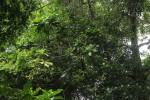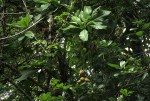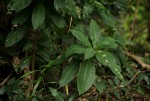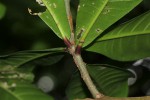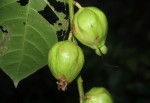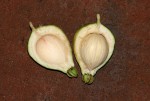| Home | > | List of families | > | Lecythidaceae | > | Barringtonia | > | racemosa |
Barringtonia racemosa
Selected images: Click on each image to see a larger version and details of the record View all images (10)
Detailed records: Display species records QDS maps by: Google Maps Point records by Google Maps
Species details: Click on each item to see an explanation of that item (Note: opens a new window)
| Synonyms: |
Barringtonia caffra (Miers) Knuth Butonica caffra Miers Eugenia racemosa L. |
| Common names: | Powder-puff tree (English) |
| Frequency: | Locally common along the coast. |
| Status: | Native |
| Description: |
Evergreen shrub or tree. Leaves crowded at the ends of branches, obovate-oblong to obovate-oblanceolate, 14-40 cm long, dark green above, paler beneath, midrib prominent beneath often purplish near the petiole; margin finely and shallowly toothed; petiole short, up to c. 1 cm long, often purplish. Inflorescences in long pendulous racemes up to 70 cm long. Flowers 4 petals with small sepals and petals 15-25 mm long, white often flushed with pink; stamens numerous, forming a central mass up to 3.5 cm in diameter, white or pinkish; flowers open at night and have an unpleasant scent. Fruit conical to ovoid, 3-7 cm long, crowned by the persistent calyx and style, fleshy when young but becoming hard, fibrous and coppery reddish-green. |
| Type location: |
India |
| Notes: | Specimens in the photographs were found along a stream appr. 50 km from the coast. |
| Derivation of specific name: | racemosa: with flowers in racemes, arranged along an unbranched inflorescence stalk. |
| Habitat: | Mostly along tidal river banks or swampy coastal localities, more rarely along streams and rivers somewhat further inland. Although not a true mangrove it may form stands in less saline parts of mangrove swamps and develop small pneumatophores. |
| Altitude range: (metres) | |
| Flowering time: | |
| Worldwide distribution: | Along the African coast from KwaZulu-Natal, South Africa to Tanzania. Elsewhere along the coasts of Tropical Asia, northern Australia, Madagascar and many Indian and eastern Pacific Islands. |
| National distribution: | N,Z,MS,GI,M |
| Growth form(s): | |
| Endemic status: | |
| Red data list status: | |
| Insects associated with this species: | |
| Spot characters: | Display spot characters for this species |
| Images last updated: | Wednesday 27 April 2016 |
| Literature: |
Beentje, H. & Bandeira, S. (2007). Field Guide to the Mangrove trees of Africa and Madagascar Royal Botanic Gardens, Kew, Richmond, Surrey, UK ISBN 978-184246-135-8 Pages 50 - 51. (Includes a picture). Burrows, J.E., Burrows, S.M., Lötter, M.C. & Schmidt, E. (2018). Trees and Shrubs Mozambique Publishing Print Matters (Pty), Cape Town. Page 657. (Includes a picture). Coates Palgrave, K. (revised and updated by Meg Coates Palgrave) (2002). Trees of Southern Africa 3rd edition. Struik, South Africa Page 782. (Includes a picture). Da Silva, M.C., Izidine, S. & Amude, A.B. (2004). A preliminary checklist of the vascular plants of Mozambique. Southern African Botanical Diversity Network Report No. 30 Sabonet, Pretoria Page 79. Fernandes, A. (1978). Barringtoniaceae Flora Zambesiaca 4 Pages 216 - 218. Under Barringtoniaceae (Includes a picture). Fernandes, A. (1980). 71. Barringtoniaceae Flora de Moçambique Junta de Investigaçoes de Ultramar, Centro de Botanica Pages 2 - 4. Under Barringtoniaceae (Includes a picture). Prance, G.T. & Jongkind, C.C.H. (2015). A revision of African Lecythidaceae Kew Bulletin 70(6) Pages 7 - 9. (Includes a picture). Siebert, S. & Mössmer, M. (Editors) (2002). SABONET Southern Mozambique Expedition 2001; Provisional Plant Checklist of the Maputo Elephant Reserve (MER) and Licuati Forest Reserve (LFR) SABONET News 7(1) Page 26. Van Wyk, B. & Van Wyk, P. (1997). Field Guide to Trees of Southern Africa. Struik, South Africa Pages 200 - 201. (Includes a picture). Van Wyk, B. & Van Wyk, P. (2013). Field Guide to Trees of Southern Africa (Second edition) Struik, South Africa Pages 228 - 229. (Includes a picture). |
Other sources of information about Barringtonia racemosa:
External websites:
African Plants: A Photo Guide (Senckenberg): Barringtonia racemosaBHL (Biodiversity Heritage Library): Barringtonia racemosa
EOL (Encyclopedia of Life): Barringtonia racemosa
GBIF (Global Biodiversity Information Facility): Barringtonia racemosa
Google: Web - Images - Scholar
iNaturalist: Barringtonia racemosa
IPNI (International Plant Names Index): Barringtonia racemosa
JSTOR Plant Science: Barringtonia racemosa
Mansfeld World Database of Agricultural and Horticultural Crops: Barringtonia racemosa
Plants of the World Online: Barringtonia racemosa
Tropicos: Barringtonia racemosa
Wikipedia: Barringtonia racemosa
| Home | > | List of families | > | Lecythidaceae | > | Barringtonia | > | racemosa |
